#Griffin & Moscoso
Text
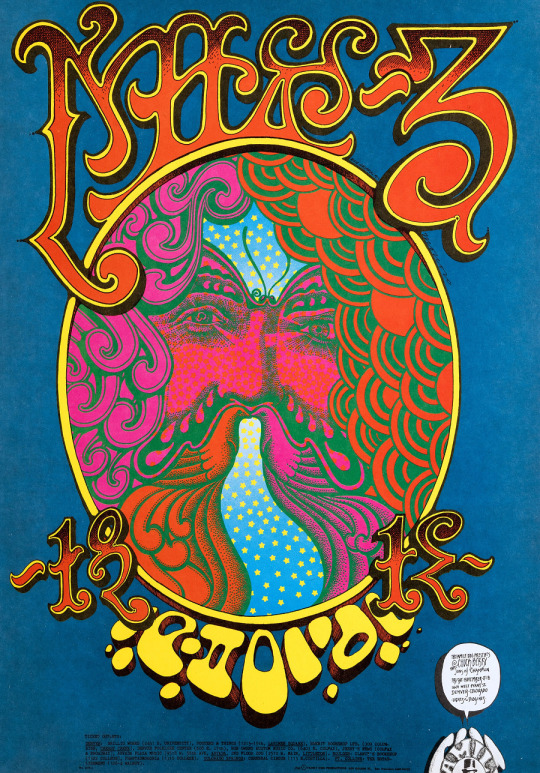
Chuck Berry, 1967.
Artwork by Griffin & Moscoso.
58 notes
·
View notes
Text
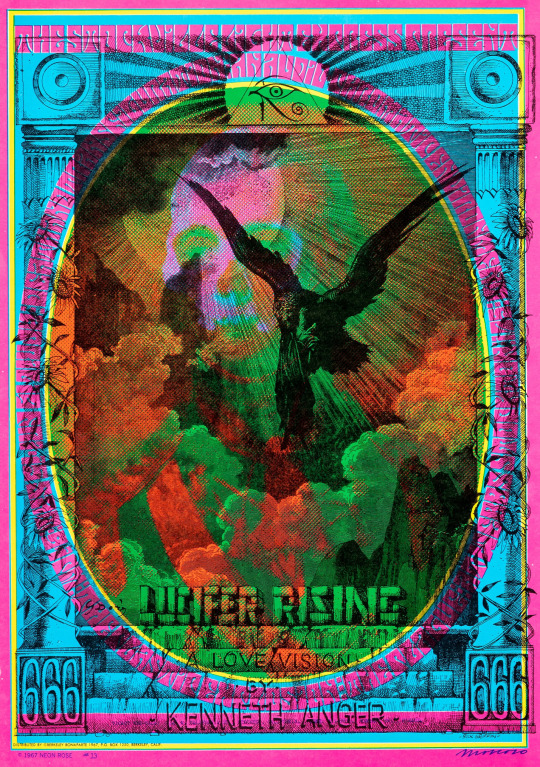

Lucifer Rising (Berkeley Bonaparte, 1967) Window Cards by Rick Griffin & Victor Moscoso
183 notes
·
View notes
Text

#jimi hendrix#the jimi jendrix experience#buddy miles express#1960s#rick griffin#victor moscoso#tea lautrec litho#rock and roll hall of fame
34 notes
·
View notes
Text
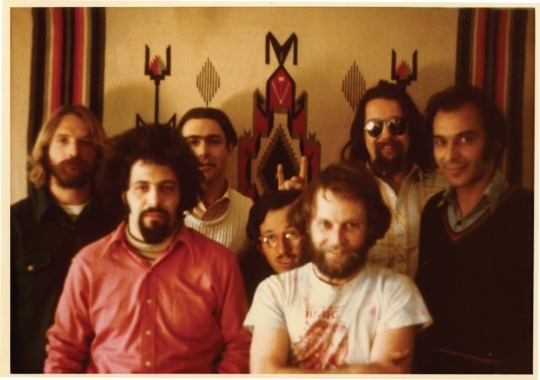
The Seven Samurai of Zap: from left, Rick Griffin, Spain Rodriguez, Robert Williams, R. Crumb, Gilbert Shelton, S. Clay Wilson and Victor Moscoso.
Credit...Suzanne Williams
#zap comix#rick griffin#spain rodriguez#robert williams#r. crumb#robert crumb#gilbert shelton#S. Clay Wilson#victor moscoso
29 notes
·
View notes
Text


#rolling stone#rolling stone magazine#the fortieth anniversary#victor moscoso#lee conklin#rick griffin#stanley mouse#alton kelley#gary grimshaw#wes wilson#leidenthal#bonnie maclean
2 notes
·
View notes
Photo
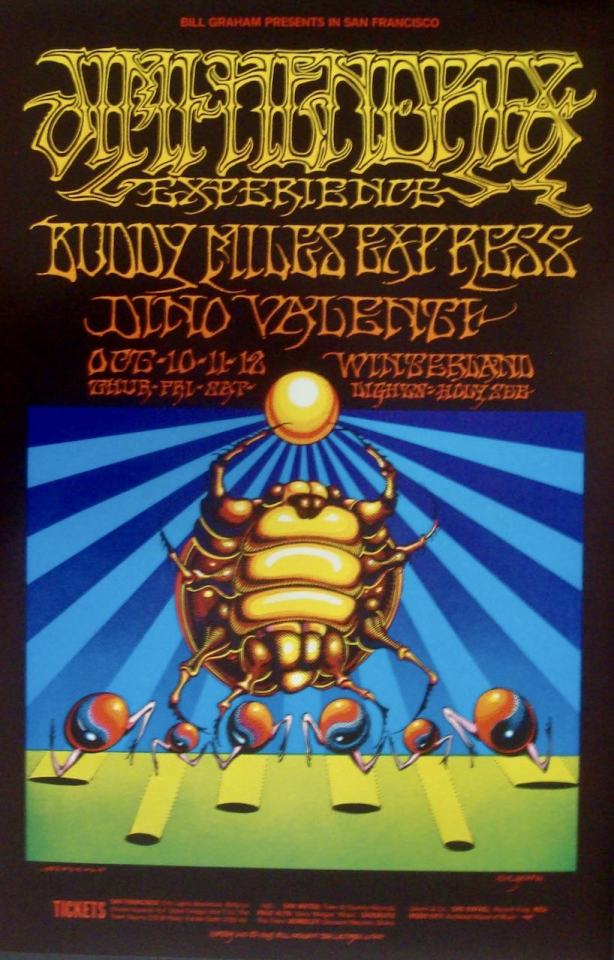

JIMI HENDRIX / IRON BUTTERFLY San Francisco concert posters (1968) - - The EYE POPPIN’ ART OF RICK GRIFFIN (Part 6/10)
Above are a set of two magnificent concert posters co designed by RICK GRIFFIN and his partner (and BIG FIVE artist) Victor Moscoso (see Part 8) for shows at Bill Graham’s Fillmore West and Winterland in San Francisco for Jimi Hendrix and Iron Butterfly
Griffin designed the very intricate lettering and main characters (the beetle / scarab as always and the iron “butterfly”) with Moscoso providing the sun rays
Another masterpieces from the BIG FIVE’s most ‘out there’ Artist who left us too soon
All our RICK GRIFFIN posters are here
ALL OUR JIMI HENDRIX POSTERS ARE HERE
If you like this entry, check the other 9 parts of this week’s Blog as well as our Blog Archives
All our NEW POSTERS are here
All our ON SALE posters are here
The posters above courtesy of ILLUSTRACTION GALLERY
#illustraction gallery#illustraction#rick griffin#victor moscoso#Rick Griffin concert poster#fillmore west#winterland#san francisco#San Francisco concert poster#psychedelic concert poster#jimi hendrix#jimi hendrix concert poster#iron butterfly#buddy miles#bill graham#fillmore west concert poster#1968#vintage
3 notes
·
View notes
Photo
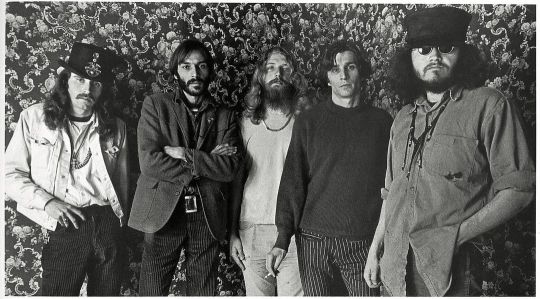
The Big Five of San Francisco poster art during the 1960s and 70s. Left to Right: Alton Kelley, Victor Moscoso, Rick Griffin, Wes Wilson, Stanley Mouse.
80 notes
·
View notes
Photo

Storia Di Musica #244 - Blue Cheer, Vincebus Eruptum, 1968
A San Francisco verso la seconda metà degli anni ‘60 successero delle cose che furono centrali nell’evoluzione della mitologia del rock. Tra i più famosi avvenimenti, ricordo che due DJ di San Francisco, Larry Miller e Tom Donahue, rispettivamente di due radio underground di Old Frisco (il nomignolo di San Francisco), la KMPX e la KSAN, iniziano a trasmettere i nuovi brani acid rock senza porsi problemi di formato, programmando i brani non dai singoli ma dagli album, addirittura trasmettendo registrazioni che non apparivano nemmeno sui dischi. In pratica il DJ diviene protagonista attivo della promozione musicale, e non mero “riproduttore” di dinamiche promotrici delle case editrici, ridefinendo, almeno per un certo periodo, integralmente la struttura dell'industria discografica americana, stimolando la nascita di emittenti radiofoniche dello stesso tipo in tutto il paese; analogo successo ebbero i primi show che oggi definiremmo multimediali, i più famosi erano i "light show" organizzati da Alton Kelley o Bill Ham che segnano la strada dell'effetto speciale nei concerti che dalla baia di San Francisco diverrà centrale in ogni concerto del mondo; Kelley e altri artisti formidabili, come Stanley “Mouse” Miller o Rick Griffin, Victor Moscoso e Wes Wilson fanno esplodere la moda delle copertine, e i poster dei concerti, psichedelici, segnando l’arte della grafica discografica in maniera decisiva; nascono i primi impresari "moderni" come Bill Graham con il leggendario teatro Fillmore aperto su Geary Boulevard e la Family Dog Production con l'Avalon Ballroom in Sutter Street. E nasce anche l’heavy metal. Ovviamente questa ultima è una provocazione, ma il disco di oggi è un antesignano del genere e una delle perle sconosciute del grande periodo californiano. I Blue Cheer furono provocatori sin dal nome, che è un famoso tipo di LSD che la leggenda vuole inventato Owsley Stanley, mecenate e tecnico del suono dei Grateful Dead, che a sua volta prende il nome da un famoso detersivo, prodotto dalla Procter & Gamble. Sono stati probabilmente i primi a fare dell’amplificazione e dell’impatto sonoro il motivo dominante della loro musica, distorcendo il blues e il rock in maniera seminale. Nascono verso la fine del 1967, quando il bassista Dick Peterson è in cerca di musicisti per mettere su una band. Si presentano in molti, ma alla fine rimangono in tre, Peterson con Paul Whaley, batterista, e il chitarrista Leigh Stephens. Le ricerche di altri membri finiscono quando vedono la Jimi Hendrix Experience suonare a Monterey e capiscono che in tre si può suonare benissimo. Come manager si trovano un personaggio terrificante, Allen "Gut" Terk, ex componente degli Hell’s Angels. Registrano subito agli Amigo Studios di Los Angeles e verso l’inizio del 1968 danno alle stampe il loro primo disco, dal titolo di latino maccheronico Vincebus Eruptum (che si potrebbe tradurre con Controllo del Disordine). Il primo singolo è una devastante e urticante cover di Summertime Blues di Eddie Cochran, che diventerà universalmente conosciuta grazie alla cover che gli Who faranno più tardi nello storico Live At Leeds (1970): arriva addirittura in classifica e spinge altissimo il loro debutto, un disco che fa della forza sonora e delle distorsioni il perno su cui scrivere la loro versione del rock acido che stava ribollendo nella baia di San Francisco. Mezz’’ora di potenza, che da Summertime Blues si sposta a Rock Me Baby, altra cover dal catalogo del maestro B.B.King, prima della prima “bomba elettrica”, Doctor Please: scritta da Peterson come “una glorificazione delle droghe” sono 8 minuti di impatto sonoro che anticipa il doom, lo stoner, e potrebbe benissimo per passare per un brano dei System Of A Down a chi non li ha mai sentiti. Non è da meno Out Of Focus, che sembra un pezzo mancante dal III del Led Zeppelin, altro gioiello meraviglioso. Parchment Farm è una cover di un famoso blues di Mose Allison, Parchman Farm, che qui viene stravolta e rivoltata come un calzino, con la voce disperata e calda di Peterson. Chiude il disco Second Time Around, scritta sempre da Peterson, che alla brutale potenza rock blues dei nostri affianca dei nuovi percorsi, avviandosi in territori proto progressive, con atmosfere che ricordano quelle dei futuri Yes. Il disco è un successo insperato, e la band in pochi mesi ne pubblica un altro, Outsideinside, registrato in parte indoor e in parte outdoor (da cui il titolo) con simpatica copertina disegnata a caricatura. Altro disco di ottimo livello, con due cover stellari di nientemeno che Satisfaction dei Rolling Stones e di The Hunter di Albert King. Non ottenendo il successo del primo, iniziano dei problemi: Gut Kesh viene arrestato per loschi traffici, Stephens lascia e Bill Graham gli proibisce di suonare ai mitici Teatri Fillmore. Con una nuova formazione pubblicano New! Improved! ma nonostante l’abnegazione di Peterson non rimane nulla di quel suono devastante e intrigante del primo disco: continueranno però a suonare per decenni, fino agli anni 2000, cambiando in tutto ben 20 formazioni. E c’è una curiosità: nel 1985 Peterson, con il fratello Jerry, resuscitando per l’ennesima volta i Blue Cheer, pubblica The Beast Is Back: come singolo, una nuova cover di Summertime Blues, che a differenza di quella di venti anni prima non ha lo stesso clamore, dato che ormai tutti conoscono il seme da loro piantato da cui è cresciuto un robusto album: l’heavy metal.
21 notes
·
View notes
Text

"BILL GRAHAM PRESENTS IN SAN FRANCISCO..."
PIC INFO: Spotlight on Abba Zaba-inspired concert poster art for DEEP PURPLE, IT'S A BEAUTIFUL DAY, and COLD BLOOD, live at the Fillmore West, November 28-30 + December 1, 1968. San Francisco, CA. Artwork by Rick Griffin (✝) and Alton Kelley.
OVERVIEW: "The third and final Rick Griffin and Alton Kelley collaboration (Griffin often collaborated with Victor Moscoso, and Kelley of course worked with Stanley Mouse on virtually all of his compositions) was a good example of both artists' use of contemporary advertising in their design. The poster features a taxi cab checker design with an "Abba-Zabba" candy bar wrapper and image of monkey working on transistor. Abba-Zabbas were candy bars made at the time by the Cardinet Candy Company of Oakland, across the Bay from San Francisco. Perhaps a favorite of one of the artists?
This poster advertises the very first tour of DEEP PURPLE who had a hit single, “Hush,” that reached #4 on the Billboard Hot 100 charts. It would be a few more years before they hit the real Big Time with the heavy metal classic, “Smoke on the Water.” Here they opened for SF-based IT'S A BEAUTIFUL DAY who were getting massive Bay-Area airplay with their hits, “White Bird,” and “Hot Summer Day.”
-- BAHR GALLERY
Source: www.bahrgallery.com/band-items/deep-purple-it-s-a-beautiful-day-1968.
#Abba Zaba#Poster Art#Vintage Style#Graphic Design#DEEP PURPLE band#Bill Graham Presents#Concert Poster#IT'S A BEAUTIFUL DAY band#Poster#Alton Kelley Art#Rick Griffin Art#60s#Fillmore West#Psychedelic posters#Abba Zaba Peanut Butter 'n Taffy#Psychedelic Art#Posters#Rick Griffin#Alton Kelley#Sixties#1960s#1968#San Francisco#Abba Zaba Candy#Bill Graham#The Fillmore
2 notes
·
View notes
Photo
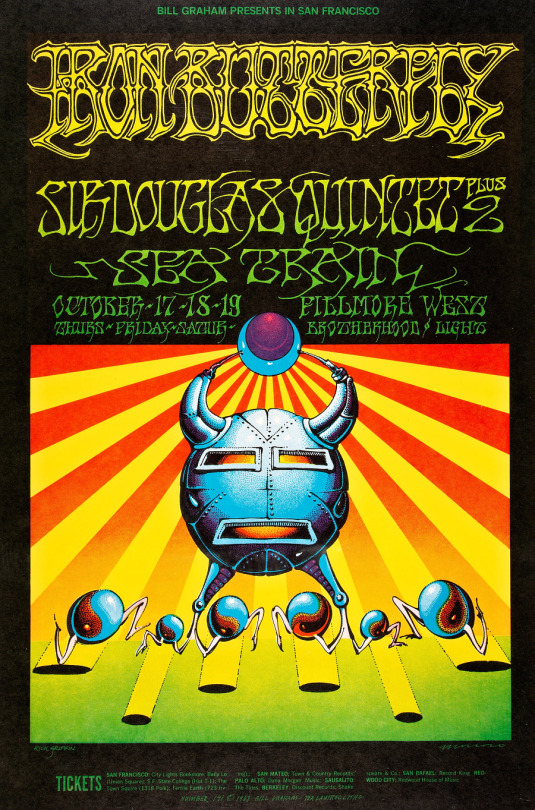
Iron Butterfly, Fillmore West, 1968.
Art by Rick Griffin and Victor Moscoso.
28 notes
·
View notes
Photo

Reposted from @collectionzz Check out tonight’s concert print for @officialthewho in Portland, Oregon! It will be available at Moda Center as well as the band’s webstore tomorrow. This art is heavily influenced by, and is a tribute to, the work of the founders of the San Francisco School of psychedelic posters aka “The Big 5”: Wes Wilson, Stanley Mouse, Alton Kelley, Rick Griffin and Victor Moscoso. Their art is still celebrated today by organizations such as @trpsorg . Produced by @collectionzz - Art by @haxloeffler & inspired by The Big Five #thewho #collectionzz #iconicbycollectionzz #concertposter #gigposter #psychedelicart #portland (at Moda Center at the Rose Quarter) https://www.instagram.com/p/Cj8KL62OUZ_/?igshid=NGJjMDIxMWI=
2 notes
·
View notes
Text
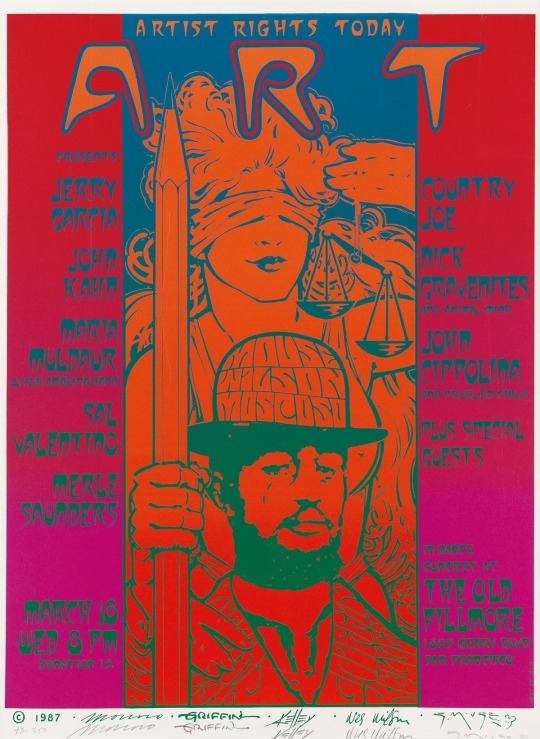
#victor moscoso#rick griffin#alton kelley#wes wilson#stanley mouse#graphic design#printmaking#rock and roll hall of fame#1980s
22 notes
·
View notes
Text

«Zap Comics Artists Show - NEW YORK - JUNE 1989 - L-R; Spain Rodriguez, S.Clay Wilson, Robert Williams, Rick Griffin, Gilbert Shelton, Robert Crumb and Victor Moscoso pose for group portrait at the opening reception of a show of Zap comix artists at the Psychedelic Solution gallery on June 8th, 1989 in New York City, New York. (Photo by Catherine McGann/Getty Images).»
10 notes
·
View notes
Text
3.11.23 Art and Synesthesia
Hello Greener, I honestly have no idea where to go from this, but I thought it would be nice if we could look into any artist who has the condition "synesthesia." Looking artists have sought to translate the emotions and rhythms of music into captivating visual experiences. Exploring this intersection can not only deepen our appreciation for both art forms but also offer a unique way to connect with the world around us. By examining the works of synesthetic artists, we can gain insight into the different ways in which they perceive and interpret sound. Through their art, these individuals are able to express a depth of emotions and sensations that go beyond typical sensory experiences. Engaging with their creations allows us to explore a realm where colors, shapes, and textures harmoniously coexist with melodies and harmonies, broadening our understanding of the interconnectedness of art and music. In embracing synesthesia as a lens for artistic expression, we can embrace a new perspective that is both enlightening and captivating.
While looking for artist with synesthesia, Wassily Kandinsky artwork is the first to immediately catch my eyes.

Composition 8 by Wassily Kandinsky (July, 1923)
Kandinsky is basically already such a cool ass guys. He has a condition called synesthesia, as I mentioned in my last blog, where all the sensory elements in the brain are having a party together. Kandinsky's "Composition" series is a prime example of how he translated music into visual art. These non-representational works are often described as visual symphonies, where color and form replace musical notes and rhythms. Each composition was intended to convey a specific emotional or spiritual message, akin to a musical composition's power to evoke feelings.
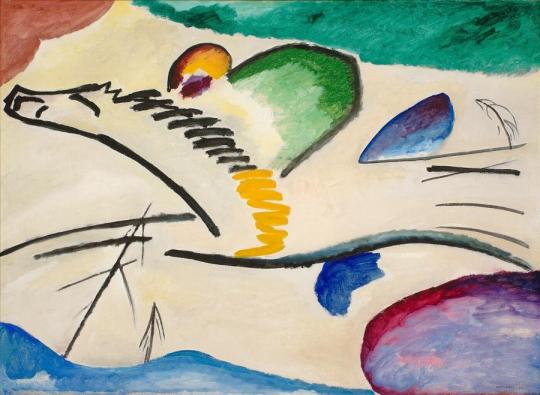
The Lyrical by Wassily Kandinsky (1911)
"lend your ears to music, open your eyes to painting, and … stop thinking! Just ask yourself whether the work has enabled you to “walk about” into a hitherto unknown world. If the answer is yes, what more do you want?"
- Wassily Kandinsky
They're all about diving deep into feelings and perception and pushing the boundaries of how we see things. then I kind of came across the psychedelic art scene, which cranked up the volume to a whole new level. 🎨🌈🚀🚀

Artist - The Beatles
Guys, let's be real. I was born 2000s, but my dad has always been a huge psychedelic rock fan. I even shocked myself by how much I knew about these song. but I'm sure my reader are way older than me. hehe sorry
The psychedelic art movement emerged during the 1960s counterculture movement, a time of social and political upheaval. The movement was a reaction against the establishment and traditional societal norms, embracing ideals of peace, love, and individual freedom. The vibrant and surrealistic works of art by people like Wes Wilson, Victor Moscoso, and Alton Kelley came to represent the counterculture movement visually and served as a form of cultural rebellion. Understanding the cultural and societal context in which the psychedelic art movement thrived helps to contextualize its impact on various aspects of visual art.
The psychedelic art movement significantly impacted album cover designs, with artists such as Rick Griffin, Stanley Mouse, and Wes Wilson creating iconic and trippy artwork for bands like Pink Floyd and The Beatles. For instance, Rick Griffin's artwork for the Grateful Dead's album "Aoxomoxoa" is often said as a quintessential example of psychedelic album cover art.

The intricate and surrealistic design not only captured the essence of the music but also pushed the boundaries of traditional album cover artwork. Similarly, Stanley Mouse and Wes Wilson's collaboration on the cover of Jefferson Airplane's album "Surrealistic Pillow" introduced vibrant colors and mind-bending patterns to the world of album cover designs. These iconic album covers not only acted as visual representations of the music but also inspired countless other artists and solidified the fusion of music and visual art. These album covers not only acted as visual representations of the music but also served as gateways into a world of imagination and exploration. The influence of psychedelic art extended beyond album cover designs and had a significant impact on other art forms, such as film and fashion. These examples demonstrate how the influence of psychedelic art transcended music and forever changed the way we perceive and interact with visual art.
Kennedy, Sharon L., "Painting Music: Rhythm And Movement In Art" (2007). Sheldon Museum of Art Catalogues and Publications. 56. https://digitalcommons.unl.edu/sheldonpubs/56
Peng, Mary L., "Exploring The Impact Of Psychedelic Art And Its Implication In The Field Of Medicine And Health: A Pilot Trial" (2023). Public Health Theses. 2322. https://elischolar.library.yale.edu/ysphtdl/2322
And honestly, it's kind of an "oh sh*t, im an idiot moment for me" here, but the answer to my question is, How can I materialize music into an object? has always been right in front of me all along. The only way I can materialize music is on vinyl, CD, cassette tape, etc.
It was even more of a big nail in my huge forehead when Oli pointed it out in the lecture, but I will talk about that more in the next post.
anyway greener, I'm feeling a bit tired after all the reading today! i will see you again on the next blog , BYE
GREEN OUT!

1 note
·
View note
Text
Psychedelic Posters: The Fusion of Art Nouveau and Counterculture

Psychedelic posters are a unique and visually striking art form that emerged in the United States during the 1960s counterculture movement. These posters were typically used to promote concerts, festivals, and other events, and they often featured vibrant colors, eye-catching imagery, and swirling, abstract patterns.
The style of psychedelic posters was heavily influenced by Art Nouveau, a late 19th-century art movement that emphasized curvilinear lines, organic shapes, and stylized natural forms. Art Nouveau artists often used these elements to create an atmosphere of beauty, mystery, and sensuality.
60's Psychedelic posters took these same elements and infused them with a new sense of energy and excitement. The artists who created these posters were often inspired by the use of psychedelic drugs, which can produce vivid hallucinations and altered states of consciousness. As a result, psychedelic posters often featured imagery that was dreamlike, surreal, and even nightmarish.
These posters weren't merely advertisements for concerts; they were works of art in their own right, designed to transport viewers into alternate realms of consciousness. Artists like Wes Wilson, Victor Moscoso, and Rick Griffin became household names in the counterculture scene, producing iconic posters for legendary bands such as the Grateful Dead and Jefferson Airplane.

In addition to their visual appeal, 60s Psychedelic posters also played an important role in the counterculture movement. These posters were used to spread the message of peace, love, and understanding, and they helped to create a sense of community among young people who were seeking alternative ways of living.
Today, psychedelic posters are still highly collectible, and they can fetch high prices at auction. Auction Daily is a leading online auction marketplace that offers a wide variety of psychedelic posters for sale. The site also features an auction-preview section where you can view upcoming auctions and an auction-calendar where you can find out about upcoming events.
In addition to psychedelic posters, Auction Daily also offers a variety of other items for sale, including art, antiques, jewelry, and collectibles. The site is a great resource for finding rare and unique items, and it offers a convenient and secure way to buy and sell online.
Popularity Psychedelic posters in the Auction Industry
Fast forward to the present day, and these psychedelic posters have become highly coveted collector's items. Their historical significance, artistic innovation, and representation of a transformative period in American culture make them incredibly appealing to collectors worldwide. This demand has led to a thriving market for psychedelic posters in the auction industry.
Here are some of the reasons why psychedelic posters are popular in the auction industry:
They are visually striking and eye-catching.
They are associated with the counterculture movement, which is a time of great social and cultural change.
They are often rare and collectible.
They can be used to decorate homes and businesses.
They can be a good investment, as their value has been steadily increasing over time.
One platform that stands out in the realm of online auctions is Auction Daily. It serves as a comprehensive resource for anyone interested in the auction world, offering a wealth of information, including auction previews, auction calendars, auction news, and connections to prominent art, antique dealers, and painting dealers.
Auction Daily provides in-depth previews of upcoming auctions, giving collectors valuable insights into the items that will be available for bidding. Whether you're interested in psychedelic posters, fine art, antiques, or any other collectible, these previews help you make informed decisions about which auctions to participate in.The auction calendar on Auction Daily keeps you up-to-date on all the major events in the auction industry. It's your go-to resource for planning your bidding strategy and ensuring you never miss an opportunity to acquire that perfect piece.
In conclusion, psychedelic posters, with their blend of Art Nouveau aesthetics and countercultural spirit, continue to be highly sought-after collector's items. The auction industry has recognized their appeal, and online platforms like Auction Daily make it easier than ever for enthusiasts to explore and acquire these treasures. So, whether you're interested in auction previews, staying updated with auction calendars and news, or connecting with art and antique dealers, Auction Daily is your indispensable companion in the world of online auctions. Don't miss out on the lots that matter most to you—let Auction Daily be your guide to the exciting world of art, collectibles, and more.
0 notes
